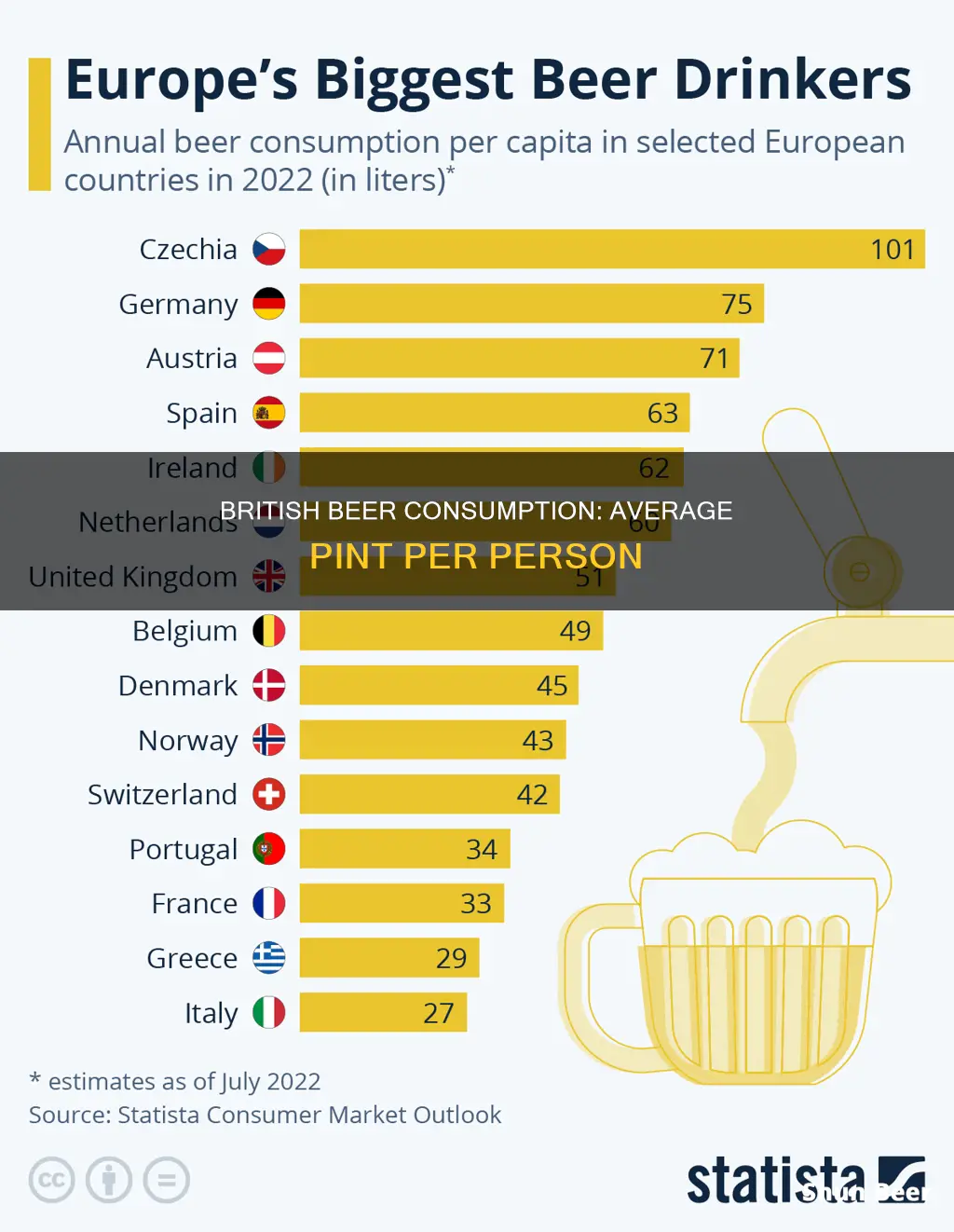
Alcohol consumption is legal in the United Kingdom, and drinking culture is an integral part of British society. Beer has historically been the most popular alcoholic beverage in the UK, but how much beer does the average British person drink?
In 2022, the average British person consumed 68 litres of beer, and this figure has decreased since 2008. While beer is the most popular drink among men, with 47% choosing it over other alcoholic beverages, only 11% of women prefer it. Binge drinking is also prevalent in British drinking culture, costing the UK economy approximately £20 billion per year.
| Characteristics | Values |
|---|---|
| Annual volume of beer consumed per capita | 68 litres (2021-2022) |
| Beer consumption among British alcohol consumers | 29% |
| Beer consumption among British men | 47% |
| Beer consumption among British women | 11% |
| Beer consumption among 18-24-year-olds | 28% |
| Beer consumption among 25-39-year-olds | 34% |
| Beer consumption among people over 40 | 37% |
| Average spend on alcohol per person per week | £6.08 (2021/22) |
| Beer/lager purchased per person per week | 496ml (2021/22) |
What You'll Learn

Beer consumption per capita in the UK
While beer has historically been the most popular alcoholic beverage in the UK, wine consumption has been on the rise since the 1960s, particularly among women. According to the Institute of Alcohol Studies, 7 out of 10 wine bottles bought in supermarkets are purchased by women. As a result, wine overtook beer as the most consumed type of alcohol in the UK in the 1980s. However, beer consumption surged back in 2018, with 8.5 billion pints sold compared to 7.4 billion 175ml glasses of wine.
In 2022, 29% of British drinkers reported consuming alcohol less often than before the COVID-19 pandemic, while 17% reported drinking more. The average British drinker spent £6.08 per week on alcohol in 2021/22, a decrease from £6.42 in 2015/16.
Among British alcohol consumers, 36% drink wine most often, 29% prefer beer, 20% opt for spirits, and 9% choose cider. Men are more likely to prefer beer (47% vs 11% of women), while women favour wine (48% vs 24% of men) and spirits (25% vs 15% of men).
Beer's Surprising Impact: Lowering Blood Sugar
You may want to see also

Beer drinking frequency
In 2022, 48% of adults (aged 16+) drank alcohol on at least one day each week, with men more likely to drink weekly than women (55% vs 42%). 8% of men and 5% of women reported drinking almost daily. The age group with the highest prevalence of drinking on at least one day each week was 65-74-year-olds, while the lowest was 16-24-year-olds (60% vs 36%). The proportion of adults drinking at least once a week declined from 54% to 48% between 2011 and 2022.
In 2022, the average UK adult bought 496ml of beer/lager per week for consumption at home and outside. This figure rose to 609ml for men.
In 2022, 24% of UK adults drank more than 14 units of alcohol per week, the equivalent of 6 pints of 4% beer. This figure was higher for men, at 32%, than for women, at 15%. The prevalence of drinking more than 14 units was highest among 55-64-year-olds and lowest among 16-34-year-olds (30% vs 19%).
In 2020, the volume of beer consumed per capita in the UK was 61 litres, increasing to 68 litres in 2021.
Managing Diabetes: Drinking Beer in Moderation
You may want to see also

Beer consumption by gender
Beer consumption in the United Kingdom has historically been higher than that of wine and spirits, but this trend has shifted over the decades. While beer was the most popular drink in Britain in the 1960s, wine consumption has been on the rise, largely driven by women. This shift in preference has resulted in wine surpassing beer in terms of market domination within the UK since the 1980s. However, in 2018, beer consumption once again took the lead as the most consumed type of alcohol in the country.
When it comes to gender differences in beer consumption, men consistently outdrink women in the UK. According to a YouGov study, 8% of British men reported drinking an alcoholic beverage every day, compared to 5% of women. Additionally, 34% of men in the 25-39 age group preferred beer as their drink of choice, while only 11% of women in the same age group chose beer. This gender divide is more pronounced among individuals over 40.
The disparity in beer consumption between men and women is further evident in the volume of alcohol units consumed. In England, men aged 65 to 74 consumed an average of 21.4 units of alcohol per week, while women in the same age group drank 10 units per week. It is recommended that both men and women should not regularly exceed 14 units of alcohol in a week, which is equivalent to six pints of 4% beer.
The higher consumption of beer among men is also reflected in the sales data. According to the Institute of Alcohol Studies, 7 out of 10 wine bottles bought in supermarkets are purchased by women, indicating that men are more likely to consume beer than women.
Hassidic Jews and Beer: What's Allowed?
You may want to see also

Beer consumption by age
Beer consumption in the UK has changed over time and varies by age, gender, and region. While beer has historically been the most popular alcoholic drink in Britain, wine consumption has been on the rise since the 1960s, particularly among women. Spirits are also a common drink, with consumption staying relatively stable over time.
According to a 2022 YouGov survey, 29% of British alcohol consumers drink beer most often, with this being more common among men (47%) than women (11%). Beer is the most popular drink among 25 to 39-year-olds (34%), while wine is favoured by those in their 40s and 50s (37%) and those over 60 (48%).
The Health Survey for England in 2022 found that 48% of adults aged 16 and above drank alcohol at least once a week, with men being more likely to drink than women (55% vs 42%). The prevalence of weekly drinking decreased with age, with 60% of 16 to 24-year-olds drinking weekly, compared to 36% of 65 to 74-year-olds.
The National Survey for Wales and Welsh Health Survey in 2022/23 showed similar results, with 44% of adults drinking alcohol at least once a week. Again, men were more likely to drink than women (55% vs 40%). However, the age group with the highest prevalence of weekly drinking was 45 to 64-year-olds (52%), while 16 to 44-year-olds drank the least (33%).
The Scottish Health Survey in 2022 also found that 49% of adults aged 16 and above drank alcohol at least once a week, with a higher proportion of men than women (56% vs 43%). Similar to the English survey, weekly drinking was least common among 16 to 24-year-olds (43%).
The Health Survey Northern Ireland in 2022/23 showed that 50% of adults aged 18 and above drank alcohol at least once a week, including 57% of men and 42% of women. The prevalence of weekly drinking was lowest among 18 to 24-year-olds (38%).
While the surveys show some variation by region, they consistently indicate that beer consumption decreases with age, with younger adults drinking more beer than older adults.
Beer and Prednisone: Is It Safe to Drink?
You may want to see also

Beer consumption by region
Beer consumption in the United Kingdom has historically been high, with the country consistently ranking highest for binge drinking culture. While the UK's consumption rates are average among European countries, they are high compared to the average of OECD nations.
In 2020, the volume of beer consumed per capita in the UK steeply declined to 61 litres, before rebounding to 68 litres in subsequent years. This is a notable decrease from 2004, when alcohol consumption peaked at an all-time high of 11.6 litres.
While wine consumption has been on the rise in the UK since the 1960s, beer was once again the most consumed type of alcohol in 2018, with 8.5 billion pints sold. This is compared to 7.4 billion 175ml glasses of wine and 1.2 billion pints of cider.
Among British alcohol consumers, 29% drink beer most often, with men more likely to choose beer than women (47% vs 11%). Beer is the most popular drink among 25 to 39-year-olds, while wine is favoured by those in their 40s, 50s, and over 60s.
Beer Ads and Drinking: Is It Allowed?
You may want to see also
Frequently asked questions
On average, each British person purchased 496ml of beer/lager for consumption per week in 2021/22. This increased to 609ml in 2022/23.
In the same period, an average of 233ml of wine was purchased per person each week, along with 84ml of cider and 70ml of spirits.
Fourteen units of alcohol per week is the recommended limit for men and women. This is equivalent to six pints of 4% beer. In 2022, 57% of British adults drank up to this limit, while 24% drank more.







